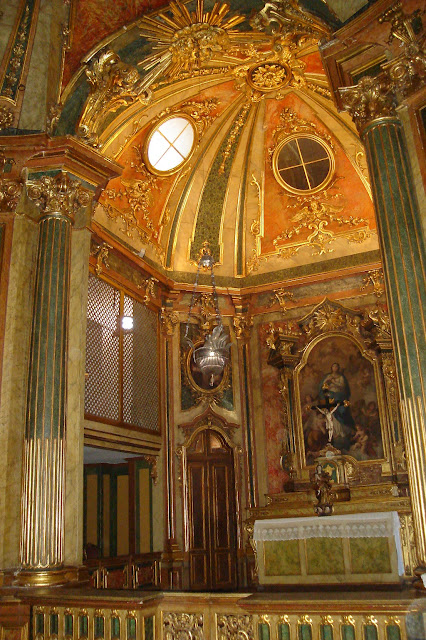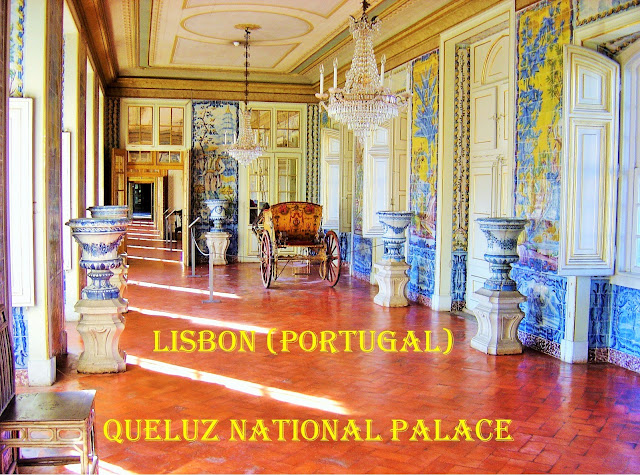The work began in 1747. By 1752, the chapel had been completed and profusely decorated with rococo carving. In contrast, the general plan would be successively altered and extended throughout the rest of the century. The first phase of building work was designed to extend the seventeenth-century residence, located in what is now the kitchen area, while the second coincided with the announcement of Price Pedro´s wedding with his nice, the future Queen Maria I ( 1734-1816), an event which took place in 1760. The purpose of the second phase was to endow the building with the spaces and ceremonial rooms befitting a royal palace.
Always intended as a summer palace, Queluz frequently welcomed the court for concerts, jousts and firework displays.
The royal family´s hasty departure for Brazil in 1807, the result of the French invasion, marked the end of palace´s most intense period of life. The court would return to Portugal in 1821. Since 1957, the Queen Maria Pavilion, the east wing adjacent to the palace, has been the official residence for visiting heads of state.
HOW TO GET THERE:
BY CAR
IC19: Lisboa-Sintra, turn off at the exit for Queluz-Palácio
38º 45’ 1.46” N 9º 15’ 28.40” W
Lisbon > Queluz
By bus (VIMECA)
Departure stations:
• Bus No. 25: Queluz (Palace), via Queluz-Belas
• Bus No. 101: Lisbon (Colégio Militar, metro station)-Tercena, bus stop: Queluz (4 Caminhos) and Estação Queluz/Massamá, roughly 15 minutes walk to the Palace
• Bus No. 106: Metro station Falagueira-Carcavelos (Praia), bus stop: Queluz (4 Caminhos) and Estação Queluz/Massamá, roughly 15 minutes walk to the Palace
By train (CP)
– Take the Sintra Line (get off at the station Queluz-Belas or Monte Abrão, roughly one kilometre from the Palace)
Departure stations:
• Estação do Oriente
• Estação do Rossio
• Estação de Entrecampos
Sintra > Queluz
By train (CP)
Sintra Line (get off at the station Monte Abrão or Queluz-Belas, roughly one kilometre from the Palace)
• Estação de Sintra
Departure stations:
• Estação do Oriente
• Estação do Rossio
• Estação de Entrecampos
Sintra > Queluz
By train (CP)
Sintra Line (get off at the station Monte Abrão or Queluz-Belas, roughly one kilometre from the Palace)
• Estação de Sintra
Train: Lisbon ( Rossio ) / Sintra, get out at Queluz – after walk 10
minutes.
TRAINS EVERY 2O MINUTES ( 20 MINUTES FROM LISBON TO QUELUZ)
LISBON - TRAIN STATION OF ROSSIO
TRAINS TO QUELUZ AND SINTRA
GPS N 38.71470; W 9.14075
To be able to know the train schedules for all locations in Portugal. The link will take you to the screen visible in the following image. Choose the departure date and you will have access to the schedules
( P ) FREE AND LARGE, IN FRONT OF PALACE
GPS N 38.75075; W 9.25791
THE PALACE
THE GARDENS OF THE PALACE OF QUELUZ
Queluz Palace was, during the second half of the eighteenth century, the Royal family´s favourite summer residence. The main façades look on to the gardens which are seen as a natural extense of the palace and which were always carefully tended. The upper gardens are laid out in French style. The New Garden or Garden of Malta was originally a lake. The Great Garden, built over the water reservoir, stands to the west of the Garden of Malta. Both are bounded by stone balustrades decorated with statues and by the Horse Gateway ( representing “ Heroic fame mounted on Pegasus”), from which main avenues of the gardens radiate.
Profusely decorated with lakes, stone sculptures and lead statues most of them from Italy and England, the gardens and the park provide a mythological route of discovery which abounds with the goods and heroes of classical antiquity and with numerous allegorical figures. Many of the statues were painted in bright colours or partially gilded. The gardens of the Palace were a privileged place of leisure and the scene for the many parties and pastimes of the Royal Family who attended firework displays, bullfights and equestrian diversions. It is easy to travel backwards in time in such places as the Tile Canal were the Royal Family sailed in small boats on summer evenings and where the Musique Pavillon, a kind of a “ Casa de Fresco”, decorated in “ chinoiserie” Music House was located, the Medallion Lake, so-called because of its delicate decoration, or Quoits Corner where quoits was played. The taste of “exotic” was always present in the Gardens of Queluz
IN FRONT OF THE ENTRANCE OF THE PALACE

























































































































































































































































































































